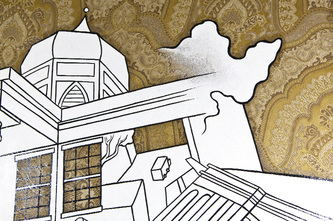Statement
This group of paintings is a direct outgrowth from my collection of observational drawings. My drawing style is a direct ink-to-paper approach that captures my response to the significances of space and time variables based on one’s perception.
Although Albert Einstein’s Theory of Relativity may be used to rationalize the impossible images in my drawings in the physical sense of contrasting frames of reference, my decision to incorporate such extreme perspective can be further justified using psychologist George Kelly’s Personal Construct Theory. Kelly asserts that an individual develops constructs his own “reality” based on past experiences. One then uses these constructs as a way of coping with apparent regularities of their lives in order to make them understandable.
The images may have a single geographical point of reference, or a radial perspective, but the constructs themselves are not likely to be reproduced in the same manner due to the influence of time. Even the artist himself often looks at an object the second time and may draw different conclusions or make new predictions, not to mention different aesthetic choices in representation. One is conceivably able to change their view of the world, according to Kelly, and in so doing they change the way they interact with it and feel about it.
The visual data as gathered by personal observation is filtered through the history of events and emotions in which I have experienced them. Which object is entitled to mass, or which should be forgotten? By analyzing the relationships I choose to create with the given data, I am able in reverse to consider the constructs that define my own personality and biases. As one who is unsatisfied with deconstructionism, I find the reinterpretation or recreation of an object is at least proposing possibilities of a more favorable version of reality.
As the original sketches morphed into large paintings, I found myself stretching embroidered silk, wool, and even burlap to create the supports. The choices of support is more than just a mimicry of pattern and color as devices to create the illusion of opulence or refinement, but serves as the physically illusive aether and a foil for my assemblages of shape and line that are otherwise devoid of texture or further description at all.
Although Albert Einstein’s Theory of Relativity may be used to rationalize the impossible images in my drawings in the physical sense of contrasting frames of reference, my decision to incorporate such extreme perspective can be further justified using psychologist George Kelly’s Personal Construct Theory. Kelly asserts that an individual develops constructs his own “reality” based on past experiences. One then uses these constructs as a way of coping with apparent regularities of their lives in order to make them understandable.
The images may have a single geographical point of reference, or a radial perspective, but the constructs themselves are not likely to be reproduced in the same manner due to the influence of time. Even the artist himself often looks at an object the second time and may draw different conclusions or make new predictions, not to mention different aesthetic choices in representation. One is conceivably able to change their view of the world, according to Kelly, and in so doing they change the way they interact with it and feel about it.
The visual data as gathered by personal observation is filtered through the history of events and emotions in which I have experienced them. Which object is entitled to mass, or which should be forgotten? By analyzing the relationships I choose to create with the given data, I am able in reverse to consider the constructs that define my own personality and biases. As one who is unsatisfied with deconstructionism, I find the reinterpretation or recreation of an object is at least proposing possibilities of a more favorable version of reality.
As the original sketches morphed into large paintings, I found myself stretching embroidered silk, wool, and even burlap to create the supports. The choices of support is more than just a mimicry of pattern and color as devices to create the illusion of opulence or refinement, but serves as the physically illusive aether and a foil for my assemblages of shape and line that are otherwise devoid of texture or further description at all.














